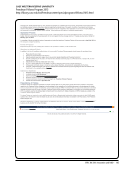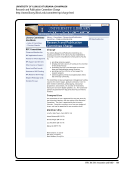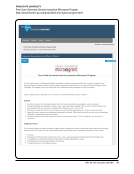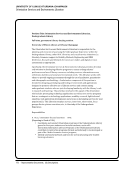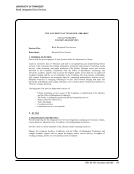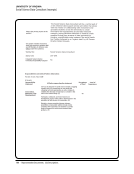74 · Representative Documents: Strategies to Support Innovation and Research
CASE WESTERN RESERVE UNIVERSITY
Kelvin Smith Library Strategic Plan 2011–2014
http://library.case.edu/ksl/aboutus/strategicplan/
Summon: Search across the library’s collections...
or access the Advanced Search Catalog Databases or eJournals directly
HOME
COLLECTIONS
SERVICES
FACILITIES
GIVE TO THE
LIBRARY
ABOUT US
Context -Mission -Vision -Values -Goals &Objectives -Visualizations
Context
A major underlying principle of this strategic plan is to highlight objectives that represent either entirely new activities for the Kelvin Smith
Library (KSL), or ones in which a substantial redirection of effort is required. Although continuing activities do not appear in the objectives,
there are some broad commitments that are bedrock principles upon which we base all KSL services. In particular, KSL will continually: (1)
build and maintain strong scholarly information resources (2) foster faculty and student engagement and productivity in their intellectual
pursuits (3) provide high quality services for our faculty, students and staff (4) work collaboratively with on-campus and external partners to
maximize the availability of information, and (5) grow our vibrant commitment to inclusion and diversity in our programs, services, and
staffing.
Mission
KSL is the knowledge and creativity commons of CWRU.
Vision
KSL will be the information laboratory for knowledge collection, connection, creation, and curation.
Values
openness
collaboration
personalized service
agility and innovation through experimentation
Goals &Objectives
KSL Objectives: Impact
I.1 -Understand CWRU Community Interests and Needs. Transform the design and delivery of KSL services by systematically engaging in research to
understand the changing needs and scholarly behaviors of faculty, undergraduate and graduate students, and by customizing services to accommodate
differences among these groups.
I.2 -Expand the Availability of Scholarly Content. Ensure that KSL is the trusted campus source for procuring, preserving, and delivering scholarly
information by:
identifying future research needs and developing a multi-year plan to provide the books, journals andother information resources to ensure that
KSL’s support of research is commensurate with that of the best practices of academic research libraries (including in support of University
international and interdisciplinary initiatives)
expanding the core of information housed or fully accessible on campus as CWRU is particularly vulnerable to the likely reduced ability of OhioLINK
to provide CWRU with the level of research collections required for excellence
developing, in consultation with faculty, comprehensive principles to govern the preferred formats for the acquisition, retention and storage of library
materials, with particular attention paid to publication periodicity and the diverse needs of different academic disciplines
creating a new library materials allocation formula for KSL library materials that is fair and transparent, and that recognizes changes in scholarly
publishing and the use of these materials at CWRU
examining and recommending actions to further the adoption of Open Access by the CWRU community
expanding the scope of special collections with a focus upon University areas of strength that supportthe curriculum and research of CWRU faculty
and students and,
exploring opportunities to grow the use of the archival materials by faculty, students and staff throughincreased marketing of available collections,
and by expanding access and preservation through digitization of both born-digital and printed materials (e.g., in science, technology, and medicine,
as well as industrial, urban, ethnic, cultural and immigration history).
I.3 -Define and Deploy a Digital Learning and Research Strategy. Engage in campus and external partnerships to define and deploy a strategy that
integrates KSL services for digital learning and scholarship that: (a) is built upon a strong technological infrastructure and embedded personal support for
faculty and students (b) provides a data management plan – including a data repository and curation services – that will fully accommodate the data
management requirements for federally-funded research and (c) provides a unified information chain for faculty and students beginning with topic
identification, and advancing through digital investigation methodology, content creation, and communication.
I.4 -Increase Student Fluency in Knowledge Discovery and Processing. Engage in a strong partnership with faculty to develop an innovative new
information literacy program that: (a) provides students with instruction at the point of need (b) effectively employs a combination of pedagogic techniques
(e.g., live presentation, self-paced learning units, recorded instruction) (c) enhances the ability of undergraduate and graduate students to comprehend and
integrate diverse information resources, and thereby contribute to their ability to create new knowledge and engage in lifelong habits of the mind and, (d)
demonstrates value through a strong outcomes-assessment component.
I.5 -Become the Campus Destination for Intellectual Pursuits. Advance student, faculty and staff recruitment and retention by: creating a
CASE WESTERN RESERVE UNIVERSITY
Kelvin Smith Library Strategic Plan 2011–2014
http://library.case.edu/ksl/aboutus/strategicplan/
Summon: Search across the library’s collections...
or access the Advanced Search Catalog Databases or eJournals directly
HOME
COLLECTIONS
SERVICES
FACILITIES
GIVE TO THE
LIBRARY
ABOUT US
Context -Mission -Vision -Values -Goals &Objectives -Visualizations
Context
A major underlying principle of this strategic plan is to highlight objectives that represent either entirely new activities for the Kelvin Smith
Library (KSL), or ones in which a substantial redirection of effort is required. Although continuing activities do not appear in the objectives,
there are some broad commitments that are bedrock principles upon which we base all KSL services. In particular, KSL will continually: (1)
build and maintain strong scholarly information resources (2) foster faculty and student engagement and productivity in their intellectual
pursuits (3) provide high quality services for our faculty, students and staff (4) work collaboratively with on-campus and external partners to
maximize the availability of information, and (5) grow our vibrant commitment to inclusion and diversity in our programs, services, and
staffing.
Mission
KSL is the knowledge and creativity commons of CWRU.
Vision
KSL will be the information laboratory for knowledge collection, connection, creation, and curation.
Values
openness
collaboration
personalized service
agility and innovation through experimentation
Goals &Objectives
KSL Objectives: Impact
I.1 -Understand CWRU Community Interests and Needs. Transform the design and delivery of KSL services by systematically engaging in research to
understand the changing needs and scholarly behaviors of faculty, undergraduate and graduate students, and by customizing services to accommodate
differences among these groups.
I.2 -Expand the Availability of Scholarly Content. Ensure that KSL is the trusted campus source for procuring, preserving, and delivering scholarly
information by:
identifying future research needs and developing a multi-year plan to provide the books, journals andother information resources to ensure that
KSL’s support of research is commensurate with that of the best practices of academic research libraries (including in support of University
international and interdisciplinary initiatives)
expanding the core of information housed or fully accessible on campus as CWRU is particularly vulnerable to the likely reduced ability of OhioLINK
to provide CWRU with the level of research collections required for excellence
developing, in consultation with faculty, comprehensive principles to govern the preferred formats for the acquisition, retention and storage of library
materials, with particular attention paid to publication periodicity and the diverse needs of different academic disciplines
creating a new library materials allocation formula for KSL library materials that is fair and transparent, and that recognizes changes in scholarly
publishing and the use of these materials at CWRU
examining and recommending actions to further the adoption of Open Access by the CWRU community
expanding the scope of special collections with a focus upon University areas of strength that supportthe curriculum and research of CWRU faculty
and students and,
exploring opportunities to grow the use of the archival materials by faculty, students and staff throughincreased marketing of available collections,
and by expanding access and preservation through digitization of both born-digital and printed materials (e.g., in science, technology, and medicine,
as well as industrial, urban, ethnic, cultural and immigration history).
I.3 -Define and Deploy a Digital Learning and Research Strategy. Engage in campus and external partnerships to define and deploy a strategy that
integrates KSL services for digital learning and scholarship that: (a) is built upon a strong technological infrastructure and embedded personal support for
faculty and students (b) provides a data management plan – including a data repository and curation services – that will fully accommodate the data
management requirements for federally-funded research and (c) provides a unified information chain for faculty and students beginning with topic
identification, and advancing through digital investigation methodology, content creation, and communication.
I.4 -Increase Student Fluency in Knowledge Discovery and Processing. Engage in a strong partnership with faculty to develop an innovative new
information literacy program that: (a) provides students with instruction at the point of need (b) effectively employs a combination of pedagogic techniques
(e.g., live presentation, self-paced learning units, recorded instruction) (c) enhances the ability of undergraduate and graduate students to comprehend and
integrate diverse information resources, and thereby contribute to their ability to create new knowledge and engage in lifelong habits of the mind and, (d)
demonstrates value through a strong outcomes-assessment component.
I.5 -Become the Campus Destination for Intellectual Pursuits. Advance student, faculty and staff recruitment and retention by: creating a

















































































































































